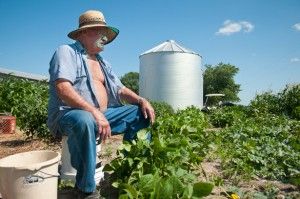Study shows consumers buy more exported food than region

June 19, 2012
In a community garden just outside of Carbondale, Matthew Weaver plucks Squash Bugs from a zucchini plant as the bugs attempt to eat what will be his and his neighbors evening meal.
Although Weaver, an SIU alumnus in forestry, said most of the food he eats is either grown or bought locally, a study released June 4 shows that most people throughout the region tend to eat differently. The study was conducted by the Crossroads Resource Center, a non-profit group that specializes in helping communities be sustainable, according to its website.
The study indicates that in a state rich in agriculture, the current food and farm economy in southern Illinois exports large amounts of wealth away from the region.
Advertisement
Ken Meter, president of the Crossroads Research Center, said the 705,000 people who live in the lower 23 counties of southern Illinois spend approximately $1.8 billion dollars on food, and $1.7 billion of that is spent on food outside of the region. Meter said if the local food industry expanded to meet 25 percent of the demand, southern Illinois would add millions of dollars to its local economy.
The research center was commissioned last year starting in September 2011 by a group of southern Illinois residents concerned with the region’s farm and food economy. Meter said he hopes the study will help concerned citizens bring together a diverse group of stakeholders involved in strengthening the local economy through local food systems development.
“The southern Illinois region has a lot of the essential ingredients it takes to make the local food economy grow,” Meter said. “It has good soil to till, there are a lot of small farms, there isn’t much industrial topography in the region and a smaller population is probably more likely to want to eat locally.”
Tim Scates, who is a partner in what he said is the region’s largest family operated farm, said the reason for this problem is simply supply and demand. Though the food grown in southern Illinois is exported to feed people throughout the world, Scates said the fact that most of the produce and meat sold in regional grocery stores comes from far away is caused by both ends of the spectrum.
“Areas that tend to grow and raise more food generally have less restrictions on the way they can go about growing it,” he said. “Here in southern Illinois there are a lot of smaller farms that either can’t or choose not to use certain pesticides and other chemicals to help increase productivity.”
Scates said consumers are often in the dark when buying exported food.
“Consumers tend to want the perfect apple, and being restricted or choosing not to use pesticides can sometimes put local farmers at a disadvantage when it comes to maintaining a healthy crop,” he said.
Advertisement*
Weaver said in his garden the daily bug and weed removal is small price to pay for an organic and sustainable food source.
A lot of the produce on the shelves in Illinois grocery stores are shipped from places like Chile and Ecuador, where they could have sprayed nearly anything on their crops, Scates said, but the consumer will never know because those companies don’t have to tell.
Meter said through purchasing produce from area farmer’s markets and co-ops, the local food economy will grow to eventually strengthen southern Illinois’ residents way of life in a more sustainable and healthy way.
“When you buy from a farmer’s market all of that value goes right to the farmer,” he said. “Not usually, but sometimes locally grown produce might be a little more expensive but what I’ve found is that when you buy something that costs more, you tend to eat it slower, it tastes better and you will always feel better about how you spend your money if your buying locally.”
Advertisement







